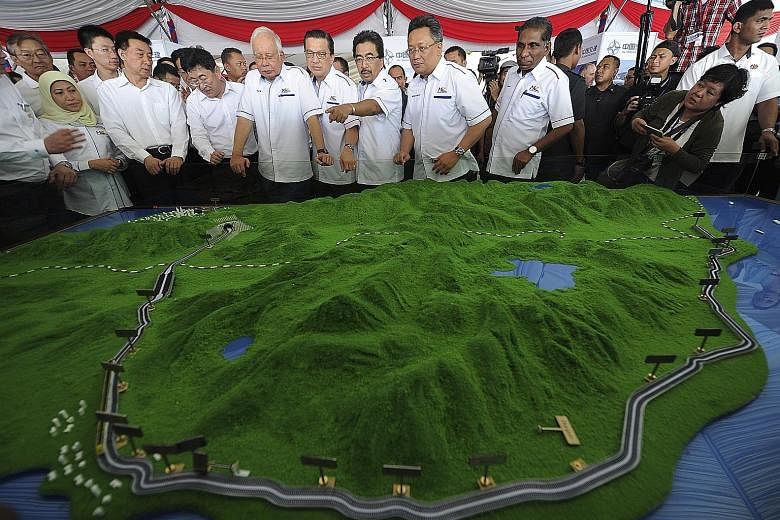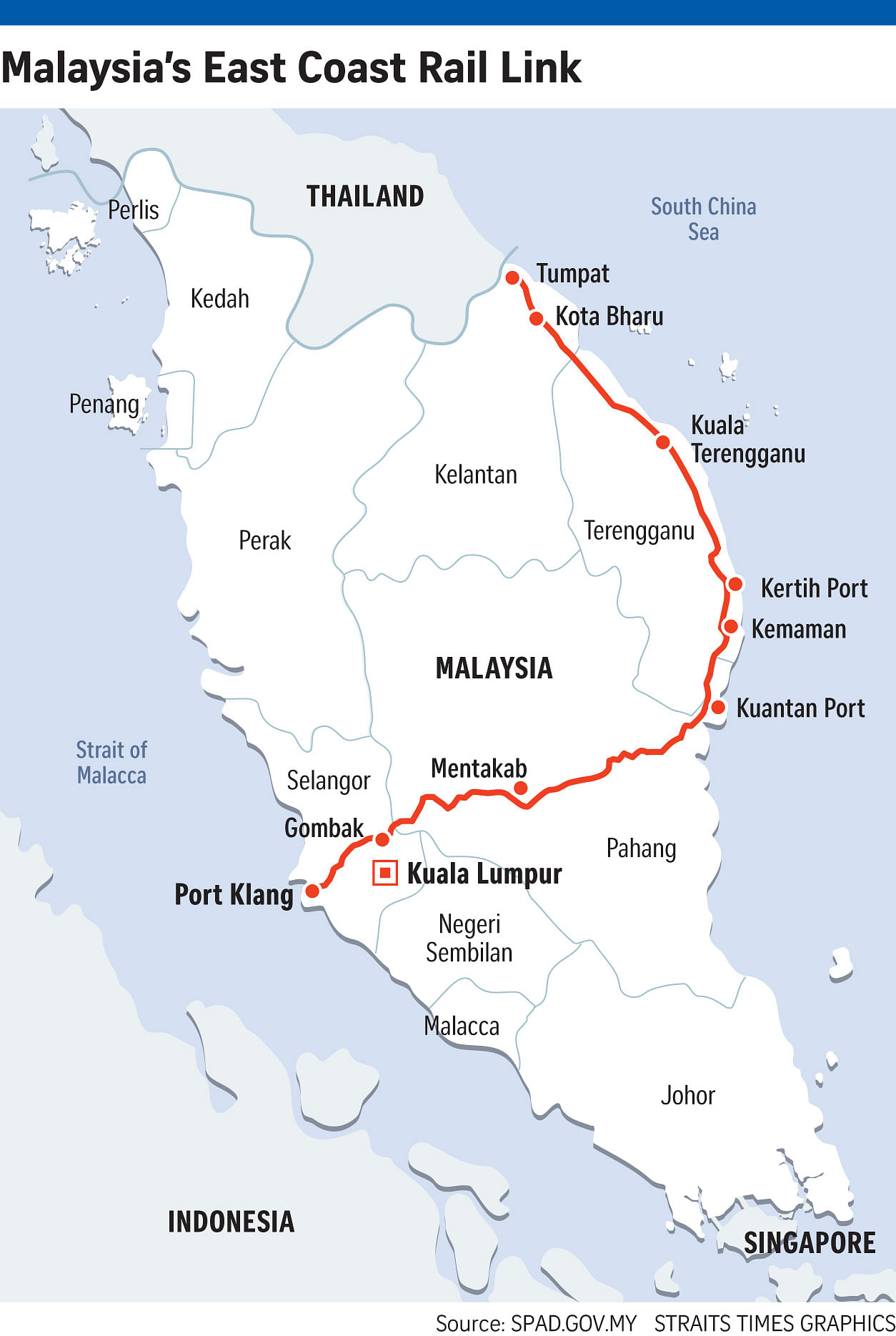Malaysia has hailed an upcoming railway linking its east coast to Port Klang on the west coast as an "alternative trade route", claiming that a projected 53 million tonnes of cargo will bypass Singapore annually by 2030.
At a ground-breaking ceremony for the East Coast Rail Link (ECRL) attended by a high-level Chinese delegation yesterday, Prime Minister Najib Razak said the rail link "is a high-impact project that will seamlessly link the Klang Valley with the states of Pahang, Terengganu and Kelantan".
The RM55 billion (S$17.5 billion) rail link, which will be built and funded by Chinese state firms, is slated for completion in 2024.
"The viability of the ECRL is undisputed as it is estimated that 5.4 million passengers and 53 million tonnes of cargo will use the ECRL service annually by 2030 as the primary transport between the east and west coast," Datuk Seri Najib said at the event in Kuantan, capital of his home state Pahang.
It is in Kuantan that a new deepwater port, also jointly developed with China, will be joined to the west coast via the ECRL to Malaysia's main port in Klang. "Hence, regional trade routes mainly centred on the busy Strait of Malacca and the South China Sea via Singapore, may leverage on the ECRL transportation, which can cater for the movement of bulky items in large volumes at lower cost," he added.
Mr Najib said the 668km line would boost the eastern region - which lags behind the rest of the country - raising economic growth by 1.5 per cent a year.
China's State Councillor Wang Yong, head of the Chinese delegation, said the electrified rail project would promote regional connectivity and was a display of bilateral economic cooperation.
Analysts said China is "keeping all options open" in securing trade routes across the Indian Ocean to its shores.
Mr Jaafar Ismail of Fergana Ventures, a Malaysian advisory firm that specialises in infrastructure and resource-based projects, previously told The Straits Times that the Port Klang to Kuantan Port "land bridge" could provide a "significant resolution" to China's over-reliance on the Malacca Strait.
Still, analysts note that the 53 million tonnes Kuala Lumpur hopes will be carried via the ECRL each year is less than 10 per cent of what the Port of Singapore handles now.
"Singapore will still be very important for the short to medium term. It is arguably still one of the most efficient ports with massive carrying capacity," senior fellow Johan Saravanamuttu of the S. Rajaratnam School of International Studies told The Straits Times.
The ECRL, which will have 12 passenger, three freight and seven combined stations, will go north from Kuantan, Pahang, to the state of Kelantan near the Thai border.
The state-owned China Communications Construction Company will build the line, with China Exim Bank providing 85 per cent of the capital at an interest rate of 3.5 per cent.
The opposition in Malaysia has argued that the rail link is unlikely to generate sufficient revenue to repay the loan from China, while critics say Malaysian firms will not reap the benefits of the project.
However, Mr Najib said China had agreed to set aside 30 per cent of the project for local contractors.
The opposition Pakatan Harapan coalition said yesterday that the resources poured into the new rail link are at the expense of the 6,000 rail workers working for the national rail company, which will not be operating the new project.
-
About the line
-
What: An electrified railway line connecting the east and west coast of Peninsular Malaysia. Cost: RM55 billion (S$17.5 billion).
Funding: 85 per cent to be financed by soft loan from state-owned Exim Bank of China, at 3.25 per cent interest. Remaining 15 per cent to be funded through sukuk, or Islamic bonds, from Malaysian investment banks.
Route: 22 stations along the 688km line from Tumpat in Kelantan to Port Klang in Selangor, via Kuantan Port.
Travel time: Four hours. The journey by road takes between seven and 12 hours.
Built by: State-owned China Communications Construction Company. It is to be completed by 2024.
Impact: An estimated 5.4 million passengers and 53 million tonnes of cargo will use the service annually by 2030. It is expected to create 80,000 jobs and increase the gross domestic product of east coast states - Kelantan, Terengganu and Pahang - by 1.5 per cent.
SOURCES: BERNAMA, THE STAR/ASIA NEWS NETWORK
A statement signed by coalition members noted the rail link will not be owned by the national rail company but by a new firm wholly owned by the Ministry of Finance.


